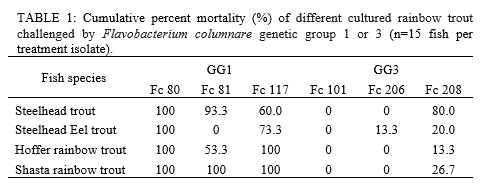VIRULENCE DIVERSITY OF Flavobacterium columnare GENETIC GROUP I AND III TO DIFFERENT CULTURED RAINBOW TROUT Oncorhynchus mykiss STRAINS IN CALIFORNIA, USA
Flavobacterium columnare is a filamentous Gram-negative bacterium responsible for significant economic losses in several freshwater fish and a re-emerging pathogen for wild and cultured salmonids in the US Pacific Northwest. Flavobacterium columnare strains have been assigned into four different genetic groups (GG) likely representing different bacterial species with some fish-host association. This study evaluated the susceptibility of four different rainbow trout (Oncorhynchus mykiss) strains cultured in California to three isolates typed in F. columnare GGs 1 and 3, the two more prevalent genetic groups affecting salmonids worldwide. The rainbow trout strains investigated are either native trout strains to California raised for conservation purposes, hatchery hybrid trout raised for sport fisheries or are imported strains selected for disease resistance or fast growth phenotypes. Virulence was determined through immersion challenges in two different strains of Steelhead trout, the Hoffer strain rainbow trout and the Shasta strain rainbow trout at 18°C. Central valley strain Steelhead trout, Eel river strain Steelhead trout, Hofer rainbow trout and Shasta strain rainbow trout challenged with GG1, presented a cumulative percent mortality (CPM) of 60-100%, 0-100%, 53.3-100%, and 100%, respectively. On the other hand, central valley strain Steelhead trout, Eel river strain Steelhead trout, Hofer rainbow trout and Shasta strain rainbow trout challenged with GG3, presented a CPM of 0-80%, 0-20%, 0-13.3%, and 0-26.7%, respectively (Table 1). F. columnare was recovered from gills and posterior kidney of moribund and recently dead fish in exposed treatments. Evaluation of up to 3 survivors in each treatment was performed to determine carrier status in gills and posterior kidney. The prevalence of F. columnare in survivors was 0% in both gills and posterior kidney of all challenged and control groups. The results suggest similar susceptibility to columnaris diseases in all strains of trout evaluated, and confirms GG1 greater virulence to trout when compared to GG3 isolates.
